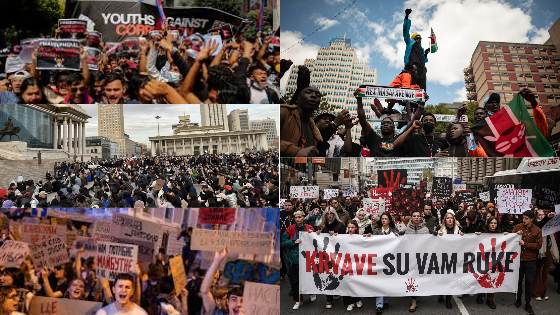This week’s resignation of Nepal Prime Minister K.P. Sharma Oli came not at the ballot box, but on the streets.
After two days of youth-led demonstrations against corrupt government and political elites, protesters set fire to parliament, clashed with police and ultimately forced Prime Minister K.P. Sharma Oli to step down. An interim leader has been appointed, with elections set for March 2026.
This flashpoint in Nepal is the latest in a striking global pattern: members of Generation Z — people born between 1997 to 2012 — have been confronting corruption. Movements in Mongolia and Kenya have followed a parallel structure to the recent one in Nepal.
A social media trend exposing “nepo kids” — children of political elites — and their visibly wealthy lifestyles ignited Nepali youth who face high unemployment and political exclusion to speak out against long-standing corruption scandals that never led to accountability.
This led to protests starting from Gen Z students and young adults in Kathmandu, Nepal spreading quickly to other urban centres. Local collectives, many without formal leadership, organized through online platforms like Discord, Instagram and local NGOs such as Hami Nepal.
A tragic first day resulted in hundreds injured and more than 50 dead after police inflicted violence on peaceful protestors. The second day of protest on Sept. 9 turned into a riot. Government buildings were burned down, foreign ministers were chased into lakes and many political officials, including the Prime Minister, stepped down from their roles.
Nepal’s case is almost parallel to Mongolia’s.
Mongolia: “Anti-Corruption Protest”
In late May 2025, following years of public frustration over alleged elite corruption, visible privilege around political families and limited opportunity for young people, tensions spiked after a social media post demonstrated the former Prime Minister’s son’s lavish lifestyle.
Student-age Mongolians in Ulaanbaatar gathered first in central squares and online spaces, then spread to other cities with loosely coordinated collectives and civil society accounts amplifying logistics on mainstream platforms and chats.
Demonstrations remained largely peaceful but persistent through late May, drawing broader crowds and sustained media attention. On the 21st day of protest, under mounting pressure and amid parliamentary turmoil, the 10-month-old governing coalition fell, prompting leadership changes while debates over media pressure and rule-of-law safeguards continued.
Since June 2024, a series of youth-led demonstrations have unfolded after years of government incompetence regarding rising costs of living; anger at perceived elites enrichening themselves while ordinary citizens struggle to make ends meet; and outrage over police abuses.
While anger and protests had been fuming around Kenya, they truly crystallized around the growing opposition towards a controversial finance bill that introduced new taxes on essential goods such as bread, cooking oil and sanitary products. Many young Kenyans interpreted the legislation as proof of a corrupt and indifferent political class.
The demonstrations were largely decentralized, leaderless and coordinated through X, TikTok, Instagram and encrypted chats. The youth had turned to digital platforms to mobilize the movement with the hashtag: #rejectfinancebill, subsequently leading the youth to organize marches, translate the bill into local language and report on events when traditional media was constrained.
They first gathered in Nairobi before the protests rolled through other largely populated areas. Turnout swelled into the tens of thousands across waves of demonstrations, accompanied by creative online campaigns and community mutual aid.
Protesters also highlighted broader issues of governance, particularly police violence and a long history of state corruption. In several instances, clashes with security forces resulted in deaths, which further fuelled public outrage.
The government responded with a mix of repression and concessions. Security crackdowns, curfews and detentions were accompanied by promises to amend or roll back parts of the finance bill.
While the government did not fall, the movement forced a national reckoning on accountability and policing and continues to reshape the political agenda heading into subsequent legislative battles.
A Formulaic Pattern
Though the countries differ, these protests reveal striking similarities.
Each movement was set off by a symbolic flashpoint — the “nepo kids” trend in Nepal, a social media post highlighting the former Mongolian Prime Minister’s son’s luxurious life and a finance bill in Kenya.
Though these were the final straws for the youth in their respective countries, the underlying reasoning for the protests remained the same across all three nations: a fight against corrupt governments living lavish lives financed by their citizens’ tax dollars, all while the citizens themselves were left with next to nothing.
All three of these countries’ youths’ frustrations manifested on social media, using it to spread awareness of the repressive systems and organize demonstrations. Gen Z protesters, often leaderless and decentralized, drove the momentum using memes, music and symbols.
The only part where the three differ is the outcome. While governments in Nepal and Mongolia fell, Kenya’s government is holding firmly, though not without concessions.
—
For governments, these movements are a warning: corruption and elite privilege are increasingly intolerable to younger generations. For youth, the challenge is sustaining momentum, avoiding repression and translating protest into institutional reform.
What connects Kathmandu, Ulaanbaatar and Nairobi is not just anger, but a generational demand: accountability, transparency and a future not corroded by corruption — vitalized by social media platforms.

